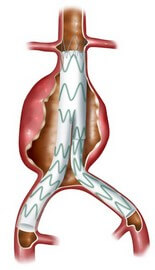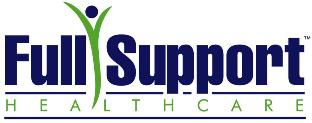What is endovascular aneurysm repair?
Endovascular aneurysm repair involves inserting a graft within the aneurysm through small groin incisions using X-rays to guide the graft into place.
The advantage of this type of repair is that there is no abdominal surgery. This technique is therefore safer than the traditional operation, and you need to spend less time in hospital. A disadvantage is that some patients have to undergo a further operation at a later stage to refine the initial procedure.
Not every patient or every aneurysm is suitable for EVAR. In particular, aneurysms arising close to or above the kidneys are more difficult to treat in this way. You will be assessed with a scan to determine if your aneurysm can be treated by endovascular repair. If suitable you will be offered a choice of type of repair by your surgeon. If this cannot be undertaken at your local hospital, you may need to travel to a centre that can perform endovascular repair.
Complications: The risk of a major complication is lower for endovascular repair, as the operation does not interfere with the circulation as much as open surgery. However, the graft attachment is not as secure as in the open operation. As a result, you may need follow up with scans to ensure that the graft has not slipped. It is estimated that about 1 in 10 patients may need a further intervention or operation on their graft.
Recovery: After uncomplicated endovascular repair, most patients return to the hospital ward for one to three days. You should be able to eat and drink normally once fully awake following your aneurysm repair. The nurses will aim to getting you sitting up and walking as soon as possible. Once you are up and about, you should be able to leave hospital, but may need painkilling tablets for up to a week.
Discussions with patients who have undergone endovascular repair suggest that it can be normal to make a full recovery in about two weeks, however some people take longer and can tire and take several months to return to the health state they had prior to the operation. During this time, you should gradually build up your level of activity back to normal. You may resume normal sexual relations as soon as you as you feel comfortable.
Return to work: Most people who are treated with endovascular repair can return to work within a month after having surgery. If you drive for a living, please read the section on driving toward the end of this information page.
Is surgery successful?
If aneurysms are successfully repaired, this prevents them blocking or bursting and there is a very high likelihood that you will return to a normal life. Full recovery takes between 3 and 6 months after open surgery and 2 to 4 weeks after endovascular repair. The speed of recovery will also be affected by your age and general fitness.
What are the risks of surgery?
As with any major operation general complications can occur including infection in the wound, chest infections or diarrhea.
There is a small risk of you having a medical complication such as:
- Heart attack
- Stroke
- Kidney failure
- Chest problem
- Loss of circulation in the legs or bowel
- Infection in the graft used to replace your aorta
Up to 1 in 10 men may have difficulty sustaining an erection following surgery due to injury to nerves which lie on the front of the aorta. It is also recognized to occur following endovascular repair. If you have problems with this, please tell your doctor, as there are treatments that may help.
Deep vein thrombosis (DVT) is a recognised risk and most patients will have treatment during their stay in hospital to prevent this. If you do develop a DVT, then you may require extra treatment for this and this may prolong your stay in hospital
If your risk of a major complication is higher than this, usually because you already have a serious medical problem, your surgeon will discuss this with you. It is important to remember that your surgeon will only recommend treatment for your aneurysm if he or she believes that the risk of the aneurysm bursting is higher than the threat posed by the operation. Your surgeon will be able to tell you the success rate for this operation in his/her unit.
Consent to store your personal information
Vascular surgeons record information about surgical interventions, including AAA repairs, on the National Vascular Database (NVD). This is a secure database that is used to help monitor and improve vascular services throughout the country. Therefore, you (or your nearest relative) may be asked to give permission for your personal information to be stored on the NVD. Although the database is a national system, strict data governance means personal details on the NVD can only be accessed by staff involved directly in an individual's treatment. Patient information is confidential and is not passed on to third parties other than healthcare professionals directly involved in an individual's care. You need to confirm with your vascular surgeon whether you are happy for them to store your personal information on the NVD.
What can I do to help myself?
Smoking. If you are a smoker the single most important thing you can do to help yourself is to give up smoking (see reference 1 below). Stopping smoking will also help to protect all of your arteries making it less likely that you will suffer from heart attacks or strokes. Giving up is not easy but there is a smoking cessation service and support groups that can help. Your vascular specialist nurse or GP practice nurse can advise you about these.
Inactivity. Gentle exercise such as walking and cycling are recommended to help to improve your overall level of fitness. Exercise helps your body to produce healthy cholesterol and this helps to protect your arteries against bad cholesterol.
High blood pressure. High blood pressure is a known risk factor for rupture of aneurysms. It is very important that you have your blood pressure checked regularly, at least every 6 months (see reference 2 & 3 below). If you have been prescribed medication for high blood pressure, you must make sure that you take it according to the instructions given.
Diabetes. If you have diabetes it is important that your blood sugar levels are well controlled.
High blood cholesterol levels (fatty substance) in your blood. You should eat a healthy balanced diet and try to reduce any excess weight. It is important to reduce the level of cholesterol in your blood: you will be given advice on how to do this. Your vascular nurse can refer you to a dietician if needed. You may be prescribed a statin drug to lower your cholesterol level and low-dose aspirin to help prevent blood clots from forming.
Driving with an AAA
If you have a small AAA (<5.5cm) you are allowed to continue to drive. The DVLA should be notified if your aneurysm reaches 6cm in diameter and you are allowed to continue to drive if you have had satisfactory medical treatment and there is no further enlargement of your AAA. If your AAA reaches 6.5cm in diameter you are disqualified from drivin (see reference 4 below).
HGV drivers are disqualified from driving if their AAA is >5.5cm, but can resume driving if AAA is successfully treated (see reference 4 below).
More information and advice about vascular health.
Contact Numbers
If you have any questions or queries you can contact the Vascular Practitioners/Nurse for your area or alternatively the secretary for your Consultant.
NB: Your surgeon will advise you on the basis of a CT scan whether it is possible to perform Endovascular Aneurysm Repair (EVAR) surgery. In some cases this is not possible and, if fit enough, you will be offered a more traditional ‘open’ operation.
References
1. DOH Smoking kills. A white paper on tobacco. The Stationery Office, London, December 1998.
2. Kannel WB, Dawber TR, McGee DL. Perspectives on systolic hypertension. The framington study. Circulation 1980; 61; 1179-1182.
3. Stamler J, Stamler R, Neaton JD. Blood pressure, systolic and diastolic and cardiovascular risks. US population data. Archives of internal medicine 1993; 153; 598-615.
4. For Medical Practitioners. At a glance guide to current Medical Standards of fitness to drive. Drivers Medical Group, DVLA, Swansea. August 2010. Whilst we make every effort to ensure that the information contained on this site is accurate, it is not a substitute for medical advice or treatment, and the Circulation Foundation recommends consultation with your doctor or health care professional.
Whilst we make every effort to ensure that the information contained on this site is accurate, it is not a substitute for medical advice or treatment, and the Circulation Foundation recommends consultation with your doctor or health care professional.
The Circulation Foundation cannot accept liability for any loss or damage resulting from any inaccuracy in this information or third party information such as information on websites to which we link.
The information provided is intended to support patients, not provide personal medical advice.









